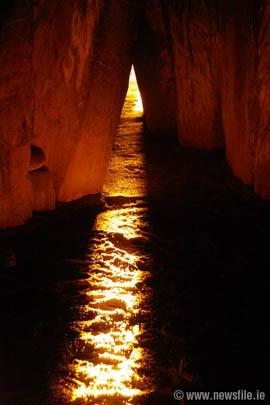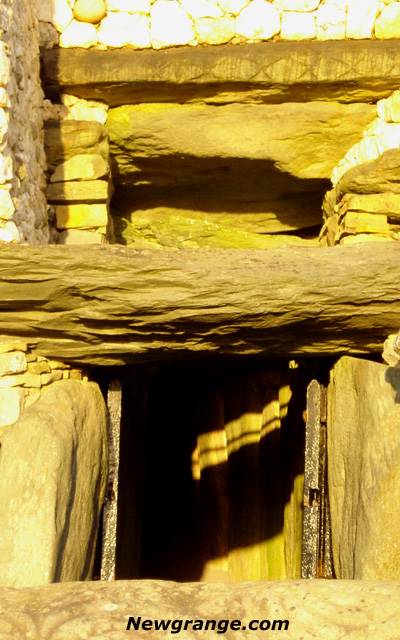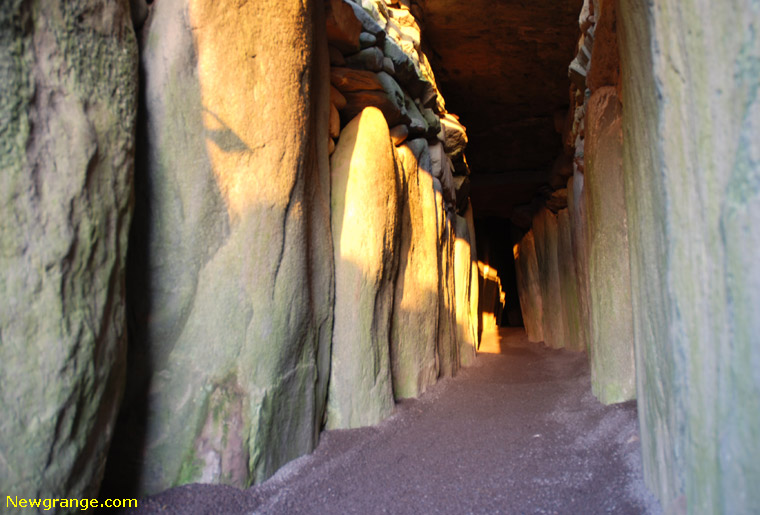Winter Solstice 2008
 Winter
Solstice 2008 was a dull damp affair at Newgrange on the morning of December 21st, the shortest day of the year. Poor weather dampened celebrations this year, cloudy
skies meant that the sun's rays failed to illuminate the passage and chamber of the 5000 year old mound at Newgrange.
Winter
Solstice 2008 was a dull damp affair at Newgrange on the morning of December 21st, the shortest day of the year. Poor weather dampened celebrations this year, cloudy
skies meant that the sun's rays failed to illuminate the passage and chamber of the 5000 year old mound at Newgrange.The prehistoric tomb was carefully aligned by its Neolithic builders so the rising sun at the Winter Solstice illuminates the chamber through a small window called a roofbox above the entrance. When skies are clear, the rising sun slowly shines all the way down the 19-metre long passage into the central chamber of the tomb, lighting it up for 17 minutes.
When Newgrange was built over 5000 years ago, the winter solstice sunbeam would have made its way to the back recess of the central chamber. Due to changes in the tilt of the Earth's axis the sunbeam now stops 2 metres from the back recess.
The Winter Solstice Webcast from Newgrange was broadcast on the morning of Sunday 21st of December 2008. Unfortunately it was a cloudy damp morning so the OPW (Office of Public Works) had to incorporate clips from the 2007 webcast into the live 2008 webcast.
Newgrange Winter Solstice Archive

- 21st December 2025 Winter Solstice.
- 19th December 2024 Winter Solstice.
- 19th December 2023 Winter Solstice.
- 20th December 2022 Winter Solstice.
- 20th December 2020 Winter Solstice.
- 18th December 2016 Winter Solstice.
- 20th December 2015 Winter Solstice.
- 19th December 2014 Winter Solstice.
- 21st December 2013 Winter Solstice.
- 18th December 2011 Winter Solstice.
- 22nd December 2010 Winter Solstice.
- 19th December 2010 Winter Solstice.
- 18th December 2010 Winter Solstice.
- 22nd December 2009 Winter Solstice.
- 21st December 2009 Winter Solstice.
- 21st December 2008 Winter Solstice.
- 21st December 2007 Winter Solstice.
- 22nd December 2006 Winter Solstice.
- 21st December 2006 Winter Solstice.
- 21st December 2005 Winter Solstice.
- 20th December 2005 Winter Solstice.
- 21st December 2004 Winter Solstice.
- 19th December 2004 Winter Solstice.
- 21st December 2003 Winter Solstice.
- 22nd December 2002 Winter Solstice.
- 21st December 2001 Winter Solstice.
Not all gloom for the winter solstice
An article by Eileen Battersby of The Irish Times - December 2008.Neither cloudy skies nor protests at Green failures could dim the conviviality of Newgrange watchers. Not even a lone star appeared in a sky most accurately described as murky. The Wise Men in search of directions may well have begun to panic. Contributing to the gloom was the menace of possible rain, as conditions remained dampish, nondescript.
Yet despite the absence of stars and without even the slightest hint of frost, Newgrange watchers stood tall against the wind, gazed at the overcast horizon and became philosophical. After all, even without a majestic sunrise, the longest night was officially over, daylight will begin to extend from now on, if only by a barely detectable second, but extend it will.
The sporadic damp of yesterday's cloud cover appeared to glower Scrooge-like at the great Neolithic monument overlooking the river Boyne. An icy, half-hearted wind feebly shook its fist at a large good-natured crowd which included a few druids, a long-haired man in a kilt, a baby in a pram and an impressively self-possessed dog.
Ironically, after several recent mornings of spectacular, even hazardous frosts, the days leading up to this year's winter solstice have been dreary affairs - as have the solstice sunrises so far, yet the forecast suggests tomorrow morning, the fifth, and final day of the winter solstice, should be clear with hopes of the sun's appearance.
Yet yesterday the mid-point of the annual solar cycle never seemed destined to bathe in the inspiring rays of light that acquire so much additional relevance during the winter solstice. Nor was there the familiar sight of the mist drifting atmospherically up off the river to gradually reveal the tall standing stones facing the monument.
Yesterday morning was one of those pragmatic affairs; night simply yielded to day. There was no theatre; the sun didn't even try to play games. There were no shadows; Newgrange's many ghosts were discreet. Aside from a fluttering glimmer of light at 8.40am, the sun decided to take no part in the proceedings. Instead lively conversations developed as solstice morning veterans attempted to describe former glorious solstices to newcomers, explaining what can, and often does, happen at this special time linking the past with present.
Here where ancient man worshipped his gods and honoured his dead through harnessing the power of this astronomical alignment which appears to draw the sunlight in the form of a warm golden beam into the great ceremonial burial mound, his descendants gather.
Cameras were poised hopefully as the minutes passed. Still no sun rose over the familiar ridge facing the monument. It seemed so unlikely that no one was even willing it to happen. But the crowd was happy, not tense with expectation. A female protester challenged Minister for the Environment John Gormley as he entered the passageway, reminding him of his failure to save the Tara landscape. Her comments encouraged other remarks; conversations strayed briefly from Newgrange and the technical achievements of our ancestors to the disappointing performance of the Greens in Government.
The robust man with the Nordic skier's hat summed it up: "They were full of big righteous talk when they were the opposition but once they got a bit of power, hah, they turned into mice." Strong support for mice as a species resulted in him quickly amending his comments: "I meant rats." "Hear, hear!," endorsed a formidable looking matron with a walking stick, "they've sold out. It's disgusting." Colourful images of self-righteous "eco rats" bearing low-energy light bulbs inspired further exchanges.

Winter Solstice Illumunation viewed from the entrance
When the solstice sunrise strikes the famous roof box and travels up the 19-metre-long passageway leading to the inner chamber beneath the corbelled ceiling it creates a moment of intense celebration. The beam brings hope for the future as well as wonder at the achievements of ancient man. But such is the ever-increasing significance of Newgrange that even in the absence of this ritual fusing of symbolism, nature and science, the solstice generates communal good will. To scan the horizon necessitates turning one's back on the monument yet it encourages the viewers to consider an agricultural landscape that has been shaped by thousands of years of farming. It is a record of continuous human settlement.
Girls wearing holly wreaths hurry towards the monument. Amazing discussions take place; imaginations tend to soar. On cue, Mike Redfern, professor of physics at NUI Galway, a good natured enthusiast, arrives: "This morning marks the beginning of the International Year of Astronomy, well it is really 2009," from an astronomical point of view it actually is 2009, "and it's for everyone" he said, and spoke of how Galileo, one-time heretic and father of modern physics, in 1609 first looked through a telescope at the Moon, the Milky Way and the moons of Jupiter.
Later, solstice pilgrims gathered at the grassy mound of nearby Dowth, more intimate and more informal than Newgrange. There during the winter solstice the afternoon sunset often illuminates the lower sections of the back wall of the chamber. But yesterday's overcast sky was unrelenting. There would be no red sunset. Still daylight lingered longer than it has of late. After we had given up all hope, a warm pink aura suffused the site, the sky brightened. Although there was no sunset, solstice watchers were appeased, content that winter had begun its slow decline.
Setting Sun Alignments
The Winter Solstice Setting Sun illuminates the chamber at the nearby Dowth mound and at the cairn on Slieve Gullion in Co. Armagh.Boyne Valley Private Day Tour
 Immerse yourself in the rich heritage and culture of the Boyne Valley with our full-day private tours.
Visit Newgrange World Heritage site, explore the Hill of Slane, where Saint Patrick famously lit the Paschal fire.
Discover the Hill of Tara, the ancient seat of power for the High Kings of Ireland.
Book Now
Immerse yourself in the rich heritage and culture of the Boyne Valley with our full-day private tours.
Visit Newgrange World Heritage site, explore the Hill of Slane, where Saint Patrick famously lit the Paschal fire.
Discover the Hill of Tara, the ancient seat of power for the High Kings of Ireland.
Book Now
Home
| Visitor Centre
| Tours
| Winter Solstice
| Solstice Lottery
| Images
| Local Area
| News
| Knowth
| Dowth
| Articles
| Art
| Books
| Directions
| Accommodation
| Contact
